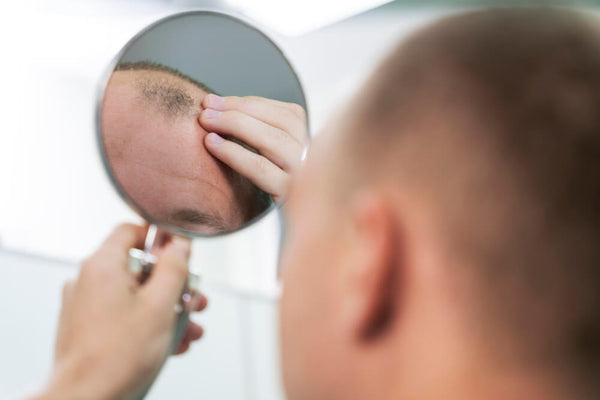Here's something I see all too often: A woman comes into my Atlanta clinic, frustrated because her hair has been gradually thinning for years. She's tried every growth oil and strengthening shampoo, but nothing stops the slow retreat of her hairline or that widening part.
"What's happening to my hair?" she asks me, her voice tinged with that particular sadness that comes from watching part of your identity slowly disappear.
Nine times out of ten, the culprit is DHT—a hormone that's essentially bullying your hair follicles into submission. And what's worse? Most women don't even know it's happening until significant damage is done.
What DHT Actually Does to Your Hair (It's Personal)
Let me break this down without the medical jargon. DHT (dihydrotestosterone) is a derivative of testosterone. In the right amounts, it's normal. But when your body produces too much, or when your hair follicles are extra sensitive to it, DHT becomes a nightmare.
Imagine your hair follicle is a cozy little home where your hair strand lives. DHT is like a bully that shows up and starts shrinking the house. First, the living room gets smaller. Then the bedroom. Eventually, the house is so tiny that your hair strand can't even fit inside anymore. That's exactly what happens—DHT literally miniaturizes your follicles until they can only produce thin, wispy "baby hairs" that barely make it past your scalp.
This is why you might notice your hair feeling finer, your ponytail getting thinner, but not necessarily seeing massive shedding. DHT doesn't always make you shed—it makes what grows back weaker each time.

The 5 Signs DHT Might Be Your Problem
This isn't just "getting older." Here's how to know if DHT is targeting your hair:
-
Your Part is Getting Wider - Slowly, steadily, like a zipper unfastening
-
Temple Thinning - Your edges are receding, creating that "Christmas tree" pattern
-
Shorter Shed Hairs - You're finding hairs that seem too short to be "normal" shedding
-
Overall Loss of Density - Your hair just doesn't feel as thick as it used to
-
Family History - Your mom, aunts, or grandmothers had similar thinning patterns
And here's what most doctors won't tell you: Black women's hair is particularly vulnerable to DHT damage because our tightly coiled hair structure already puts stress on our follicles. Add DHT to the mix, and it's a perfect storm for thinning.
Why That Minoxidil Isn't the Long-Term Answer
I know you might be using minoxidil (Rogaine). And yes, it can help—temporarily. But here's the reality: minoxidil is like giving your hair follicles caffeine. It gives them energy to grow, but it does nothing to stop the DHT bully from continuing to shrink their home.
This is why so many women become "minoxidil-dependent"—the moment they stop using it, all the progress disappears because the underlying DHT attack never stopped.
Our Approach: Actually Blocking DHT, Not Just Masking It
At Nina Ross Hair Therapy, we don't just stimulate growth—we protect your follicles from the attack itself. Here's how we approach DHT differently:
1. We Test, Don't Guess
We run comprehensive hormone panels to see exactly what's driving your DHT production. Is it insulin resistance? High stress? Perimenopause? We find the source so we can actually turn off the tap.
2. We Use Targeted DHT Blockers
Unlike the harsh pharmaceuticals that can come with sexual side effects, we use natural, therapeutic-grade DHT blockers like saw palmetto, reishi mushroom, and pumpkin seed oil. Our DHT-Blocking Supplements are formulated to stop the conversion of testosterone to DHT without the scary side effects.
3. We Treat From the Inside and Outside
While we're balancing your hormones internally, we also use scalp injections with DHT-blocking serums applied directly to your thinning areas. It's like sending reinforcements right to the battlefield.
4. We Address the Whole Picture
Since sugar and stress both spike DHT production, we work with you on dietary changes and stress management techniques that actually make a difference. We might not tell you to eliminate all sugar, but we'll help you understand which types are most inflammatory for your body.
5. We Combine with Regenerative Treatments
For follicles that have already been damaged, we use PRP therapy and exosome treatments to reverse the miniaturization process and bring those shrunken follicles back to life.

This Isn't About "Curing" Baldness—It's About Keeping What You Have
The most important thing to understand about DHT-related hair loss is that it's progressive. The earlier you intervene, the more hair you can save. I've seen too many women wait until their pattern is severe, when we could have preserved so much more if they'd come in when they first noticed their part widening.
Ready to Protect Your Follicles From the Inside Out?
If you're tired of watching your hair gradually thin and feeling powerless to stop it, book your Hair Therapy Evaluation with us for just $99. Let's run the labs, create a real plan to block the DHT, and start rebuilding what's been lost.














